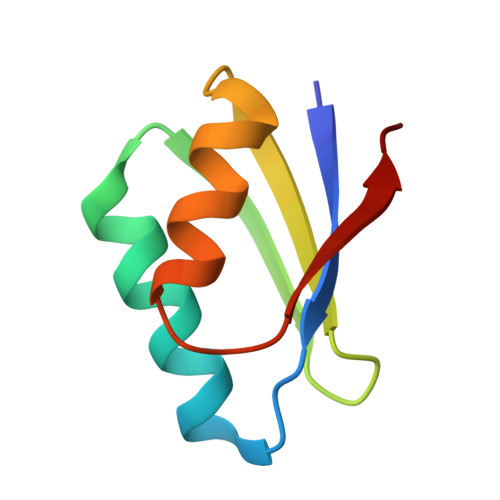Oxaliplatin Binding to Human Copper Chaperone Atox1 and Protein Dimerization
Belviso, B.D., Galliani, A., Lasorsa, A., Mirabelli, V., Caliandro, R., Arnesano, F., Natile, G.(2016) Inorg Chem 55: 6563-6573
- PubMed: 27305454
- DOI: https://doi.org/10.1021/acs.inorgchem.6b00750
- Primary Citation of Related Structures:
4QOT - PubMed Abstract:
Copper trafficking proteins have been implicated in the cellular response to platinum anticancer drugs. We investigated the reaction of the chaperone Atox1 with an activated form of oxaliplatin, the third platinum drug to reach worldwide approval. Unlike cisplatin, which contains monodentate ammines, oxaliplatin contains chelated 1,2-diaminocyclohexane (DACH), which is more resistant to displacement by nucleophiles. In solution, one or two {Pt(DACH)(2+)} moieties bind to the conserved CXXC metal-binding motif of Atox1; in the latter case the two sulfur atoms likely bridging the two platinum units. At longer reaction times, a dimeric species is formed whose composition, Atox12¡¤Pt(2+)2, indicates complete loss of the diamine ligands. Such a dimerization process is accompanied by partial unfolding of the protein. Crystallization experiments aiming at the characterization of the monomeric species have afforded, instead, a dimeric species resembling that already obtained by Boal and Rosenzweig in a similar reaction performed with cisplatin. However, while in the latter case there was only one Pt-binding site (0.4 occupancy) made of four sulfur atoms of the CXXC motifs of the two Atox1 chains in a tetrahedral arrangement, we found, in addition, a secondary Pt-binding site involving Cys41 of the B chain (0.25 occupancy). Moreover, both platinum atoms have lost their diamines. Thus, there appears to be little relationship between what is observed in solution and what is formed in the solid state. Since full occupancy of the tetrahedral cavity is a common feature of all Atox1 dimeric structures obtained with other metal ions (Cu(+), Cd(2+), and Hg(2+)), we propose that in the case of platinum, where the occupancy is only 0.4, the remaining cavities are occupied by Cu(+) ions. Experimental evidence is reported in support of the latter hypothesis. Our proposal represents a meeting point between the initial proposal of Boal and Rosenzweig (0.4 Pt occupancy) and the reinterpretation of the original crystallographic data put forward by Shabalin et al. (1 Cu occupancy), and could apply to other cases.
Organizational Affiliation:
Institute of Crystallography, Consiglio Nazionale delle Ricerche , via Amendola 122/o, 70126 Bari, Italy.


















